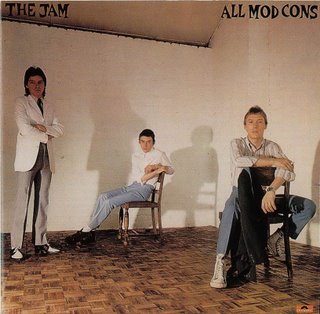
The Front Cover
This album marks the point when The Jam came of age. The year was 1979, and it was their third release – their first album (“In The City”) was very well-received whereas the second one (“This Is The Modern World”) was consistently panned. Both albums were released in 1977.
It includes what most people (count me in) deem as their greatest song: “Down In The Tube Station At Midnight”. Note that although “Tube Station” is the song most people associate with the band, it was not that wildly successful when the album was released. It was a top 20 hit, but it went nowhere near the top slots of the charts then.
The song deals with themes of urban violence and it features an excellent set of lyrics that eventually start meandering, accompanying the confusion of the last segment of the song brilliantly. Foxton and Buckler are impeccable, providing one of the most intricate performances they ever put forth. The bass in particular plays a melodic role that made it all too clear that while Bruce could never catch up with Paul lyrically by then (they both wrote when the band had started) his instrumental contribution was never to be demeaned.
A song that echoes the themes of violence of “Tube Station” is “A Bomb In Wardour Street”, where Paul lamented the role that aggressiveness had taken in the whole punk scene. He explained that people once went to gigs to see new bands, but then they started attending just to kick each other in.
“A Bomb In Wardour Street” was the first single from the album. It was released in conjunction with a cover of “David Watts” (the Kinks’ popular song) where Paul and Bruce traded vocals, and which did quite well on the charts.
Speaking of The Kinks, the album features two character sketches a la Ray Davies: “Mr. Clean” and “Billy Hunt”. The former is a sharp criticism on the austere old Englishmen that “kicked their TV sets after seeing The Sex Pistols” (Weller), whereas the latter is a contagious vignette of a downtrodden boy who enumerates the humiliations every person his age goes through when working for the first time. He ends up retreating to an illusory world of superheroes and bionic powers when things become too much. This fantasy world is obviously polluted by the whole experience, as the illusion is marred by real difficulties – the difficulties grown-ups have to face way too often in life. In the end, a person is bound to mature by renouncing to these fantasies as retiring there would simply mean tarnishing them without repair.
There are also three “love” songs, of which only “English Rose” works for me. The song is performed just by Weller – he plays the acoustic guitar and handles all vocals. The other two love songs are “Fly” (a bit saccharine for me) and “It’s Too Bad”, a song that highlights the connection with The Who in the worst light. The opening tune is not that realized either – it is a short snippet that goes by too quickly and when it is over you are left wondering “Uh?”. Fortunately, the second song (“To Be Someone”, later covered by Noel Gallagher from Oasis) sets everything to right.
The two songs that I haven’t mentioned yet are actually very good – “In The Crowd” closes the first side inventively enough (watch out for that backwards guitar), whereas “The Place I Love” is one of the few Jam songs Paul still plays to this day.
This album consolidated The Jam and placed the cornerstone for the impact and successes that were soon to come. Although their two previous records have high points (most notably the first one), this is where I advice you to start your collection of their studio albums.
Rating: 8/10

Pingback: Sound Affects (The Jam) – Album Review | MusicKO